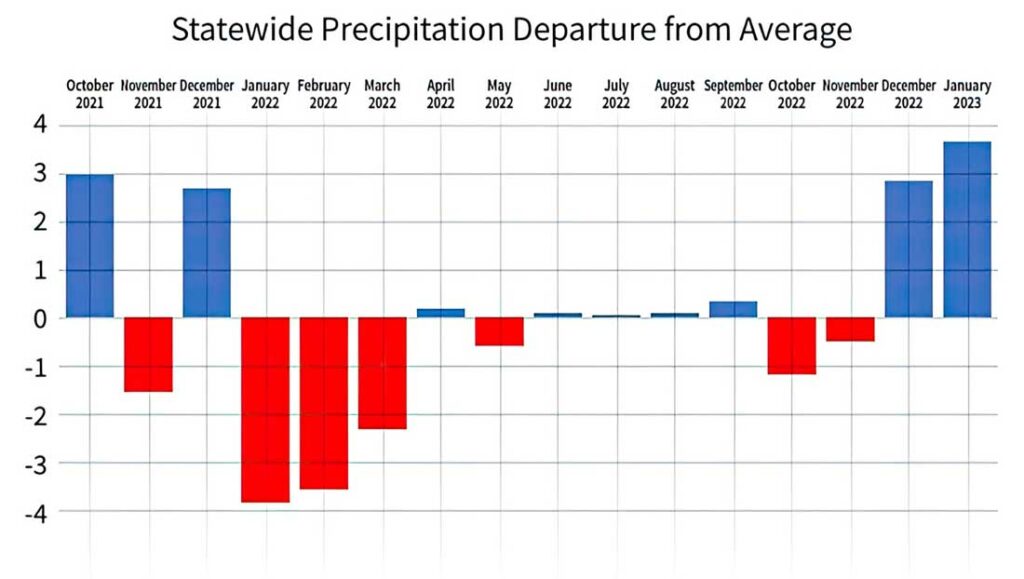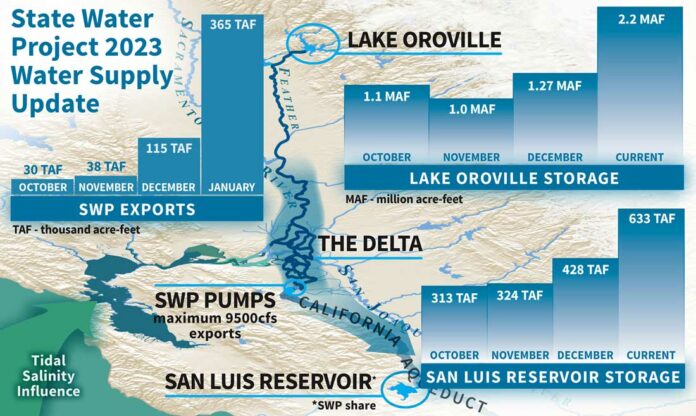In the wake of a series of powerful winter storms that lashed California for three weeks in January, the state announced Jan. 26 that it will deliver more water than expected from its major storage and delivery system.
All 29 public water agencies—serving 27 million people—that pull water from the State Water Project can expect to receive 30% of requested deliveries, up from just 5% of requested amounts announced in December.
“We are not out of drought in California but this certainly makes a significant dent,” said Department of Water Resources Director Karla Nemeth, who called the announcement “a little bit of good news.”
The increased allocations are based primarily on water storage levels at the state’s largest reservoirs, Lake Oroville and San Luis Reservoir.
Oroville is currently at 63% of capacity and 110% of average for this date and San Luis is at 56% of capacity and 77% of average.
Many other reservoirs across the state are doing similarly well, but water managers cautioned against unbridled optimism, since it’s not clear how much more precipitation will fall between now and April 1, which typically marks the end of the rainy season.
“This could very well end up being simply an average water year,” Nemeth said. “I know it doesn’t really feel like it right now.”
Gov. Gavin Newsom released a statement saying the state is working to “modernize” its storage and delivery infrastructure to better capture precipitation as climate change intensifies California’s weather extremes.
“Thanks to the water captured and stored from recent storms, the state is increasing deliveries to local agencies that support two-thirds of Californians—good news for communities and farms in the Bay Area, San Joaquin Valley and Southern California,” Newsom said.
While any increase in water deliveries from the state is welcome news to local water systems, the 30% allocation is only about half of what the state delivers on an average year and it’s unclear how much of the recent deluges will make it into groundwater basins for future use.
Additionally, the Colorado River watershed is still struggling through a historic dry spell so far only far north Del Norte County has been removed from a drought classification by the U.S. Drought Monitor, with most other parts of the state still lingering under “moderate” or “severe” conditions.
“Our message is that three weeks of storms doesn’t erase three years of drought,” said Kirsten Struve, assistant officer for water supply at the Santa Clara Valley Water District, which gets about 40% of its supply from the state system and the federally run Central Valley Project.
“Last year we had a very wet December and then we had the driest three-month period that followed,” Struve said. “It’s a little too soon to celebrate.”
Struve said none of the water conservation efforts implemented to ease the worst of the drought’s impacts have stopped and she urged people to continue to save as much water as they can.
“The news has been great of course, but we’re still in moderate drought and we want to make conservation a way of life,” Struve said.
Still, more good news could be just around the corner if the Sierra Nevada snowpack, which wasn’t included in the state’s decision to increase water allocations, turns out to be as healthy as it currently looks, with many locations currently measuring well above 100% of average.
Also, allocations from the federal Central Valley Project will come out towards the end of February and could add even more supplies to beleaguered local water systems.
“The snowpack is looking really good and we’re very hopeful for a good water supply this year,” said Cindy Kaw, Valley Water’s imported water manager. “We’ll see how the hydrology unfolds this year.”
Copyright © 2023 Bay City News, Inc.









